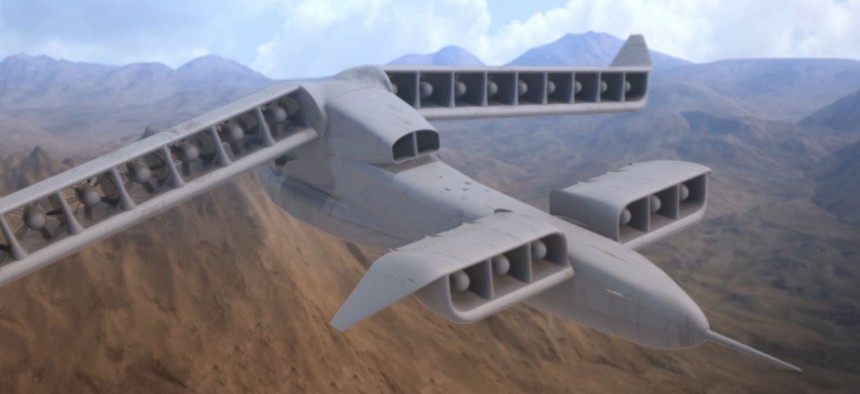DARPA's high-speed vertical-lift plane goes to Phase 2
Aurora Flight Sciences' design for the VTOL X-Plane project aims to improve hovering efficiency while also increasing airspeed.
A Pentagon project to develop a “radical” new hybrid aircraft is moving into Phase 2, which researchers hope will conclude with a demonstration of a craft that can take off, land and hover like a helicopter but fly with the speed of a plane.
The Defense Advanced Research Projects Agency has awarded Aurora Flight Sciences a contract for the next phase of the project, which is called the VTOL X-Plane for vertical takeoff and landing Experimental Plane. The demonstrator aircraft will be unmanned, although DARPA said the project should yield technologies that could be applied to manned aircraft as well.
Aurora’s design, submitted during a first phase that also included submissions from three other contractors, differs from some past VTOL plane designs. It features two long wings, each with nine ducted fans, and two small, three-fan winglets, known as canards, near the aircraft’s nose. The fans would be rotated as needed to accommodate flight, hovering or transitioning between the two, DARPA said in a release.
The design includes “truly new elements of engineering and technology that show enormous promise for demonstration on actual flight vehicles,” said Ashish Bagai, DARPA program manager. “This is an extremely novel approach. It will be very challenging to demonstrate, but it has the potential to move the technology needle the farthest and provide some of the greatest spinoff opportunities for other vertical flight and aviation products.”
VTOL aircraft exist already, but combining vertical capabilities with fast flight has been a challenge because the requirements for each are very different, DARPA said. The agency launched the X-Plane project in October 2013, and in March 2014 awarded Phase 1 contracts to four companies based on their designs—Aurora, Boeing, Karem Aircraft and Sikorsky Aircraft (Lockheed Martin subsequently acquired Sikorsky in July 2015).
The goal of the project is to develop an aircraft that can:
- Hit a top flight speed of 300 knots to 400 knots (345 to 460 mph).
- Raise aircraft hover efficiency from 60 percent to at least 75 percent.
- Present a more favorable cruise lift-to-drag ratio of at least 10, up from 5-6.
- Carry a payload weighing at least 40 percent of the vehicle’s projected gross weight of 10,000-12,000 pounds.
The aircraft will have electric power generation, using a turboshaft engine of the kind used in V-22 Osprey tiltrotor aircraft to provide 3 megawatts of power, which DARPA said is about equal to that of a commercial wind turbine. The agency also is looking for a modular wing design to increase efficiency and a flight control system that would improve maneuverability by controlling the trust of each fan.
“Imagine electric aircraft that are more quiet, fuel-efficient and adaptable and are capable of runway-independent operations,” Bagai said. “We want to open up whole new design and mission spaces freed from prior constraints, and enable new VTOL aircraft systems and subsystems.”
DARPA is hoping that a VTOL X-Plane demonstrator will be ready for test flights sometime in 2018.





